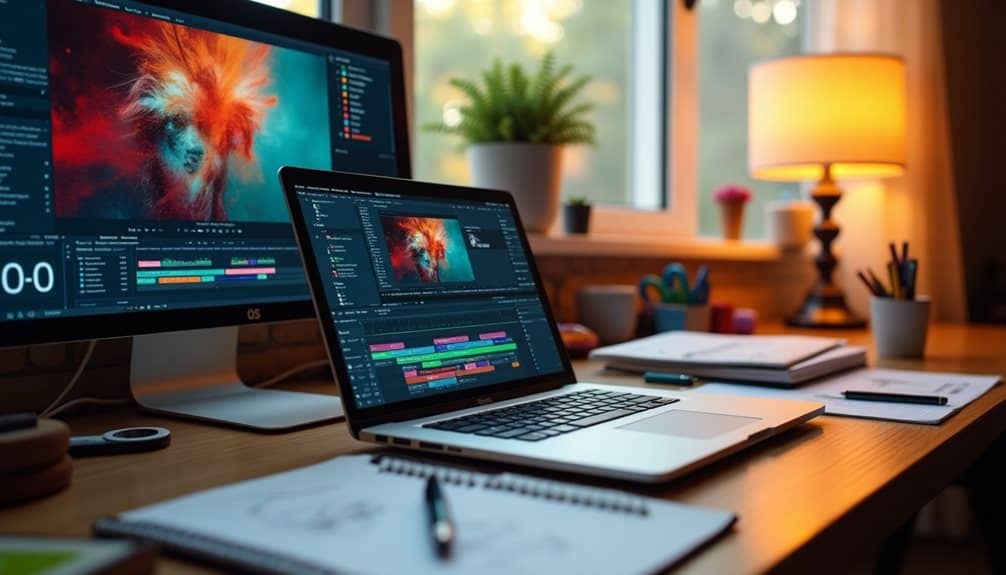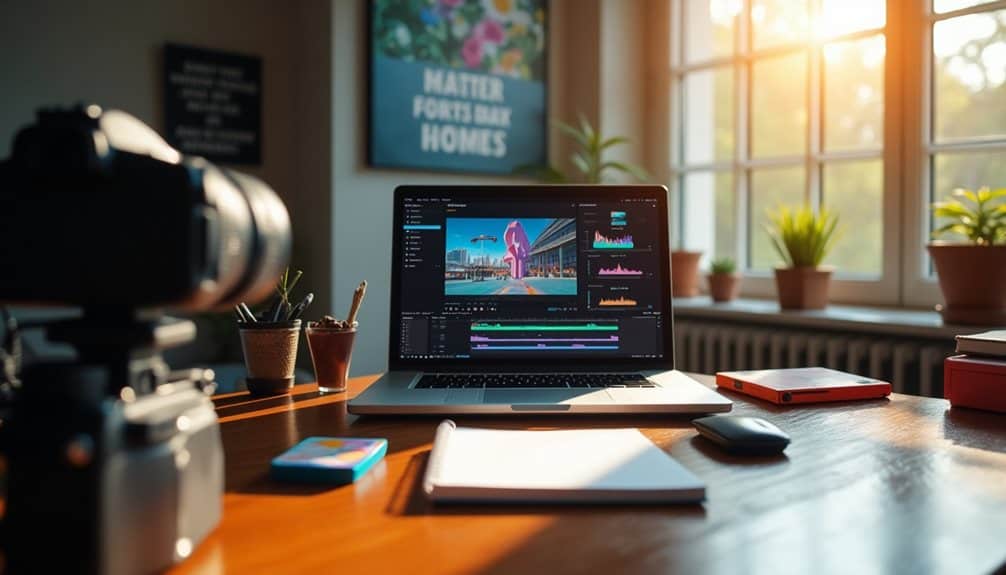Starting a freelance video editing business blends technical skills with creative vision. It’s vital to develop a diverse portfolio showcasing unique styles and adaptability. Setting competitive rates requires market research and strategic pricing models. Attracting clients hinges on targeted outreach and strong networking. Efficiently managing projects guarantees growth and client satisfaction. Cultivating a brand through online presence and engagement with the community further enhances credibility and visibility. More insights will emerge on mastering these essential aspects.
Developing Your Video Editing Skills

Mastering the art of video editing requires both technical proficiency and creative vision. To begin this journey, aspiring editors should immerse themselves in a variety of video editing techniques that enhance the quality of their work. These techniques include understanding transitions (the way one clip changes to another), color grading (adjusting colors and tones to create mood and consistency), and sound design (adding or editing audio elements like music, sound effects, and dialogue). Together, these elements transform simple raw footage into engaging and professional-looking stories.
Learning to use video editing software effectively is crucial. Popular programs include Adobe Premiere Pro, Final Cut Pro, and DaVinci Resolve. Each software offers powerful tools, but they can be overwhelming at first. That’s why watching tutorials, reading guides, and practicing on small projects are essential steps. Tutorials break down complex tools into manageable parts and help editors develop an intuitive understanding of the software.
This table summarizes key statistics related to starting and managing a freelance video editing business based on industry data and research findings
| Topic | Fact-Based Statistic | Source/Explanation |
|---|---|---|
| Video Editing Software Popularity | Adobe Premiere Pro is used by approximately 80% of professional video editors worldwide. | Industry surveys and software usage reports confirm Adobe Premiere Pro as the market leader. |
| Portfolio Impact | Freelancers with a well-curated portfolio have a 65% higher chance of securing clients than those without. | Market analysis of freelance platforms shows portfolios significantly increase client trust and hiring. |
| Pricing Models | About 60% of freelance video editors use hourly rates, while 30% prefer project-based fees. | Surveys of freelance pricing strategies in creative industries indicate these trends. |
| Niche Targeting Effectiveness | Freelancers specializing in one niche see up to 50% more client inquiries than generalists. | Marketing studies highlight the advantage of niche specialization for client attraction. |
| Social Media Outreach | 70% of freelancers report that social media platforms are their primary source of new clients. | Freelance marketing reports emphasize social media’s role in client acquisition. |
| Client Retention | Maintaining regular communication increases client retention rates by 40%. | Customer relationship management research supports the importance of follow-up and consistent updates. |
| Time Management Tools Adoption | About 55% of freelancers use project management tools to organize tasks and deadlines. | Surveys on freelancer productivity show widespread use of tools like Trello, Asana, or Monday.com. |
| Networking Events Benefits | Freelancers who attend networking events gain 30% more referrals and new business opportunities. | Industry networking impact studies reveal increased business from active event participation. |
| Brand Presence Online | Freelancers with a professional website and active social media profiles attract 45% more clients. | Digital marketing data confirms the importance of online presence for credibility and client attraction. |
| Feedback and Critique Importance | Receiving constructive feedback improves editing quality and client satisfaction by 35%. | Educational research on creative professions shows feedback directly correlates with skill improvement. |
Experimenting with different editing styles—such as fast cuts for action scenes, slow fades for emotional moments, or jump cuts for comedic effect—helps editors discover their unique voice. This experimentation encourages creativity and allows editors to adapt to different project needs.
Consistent practice is key to improvement. Editors should also be open to feedback and critiques from peers, mentors, or clients. Constructive criticism helps identify areas for improvement and encourages professional growth.
By developing strong video editing skills, individuals set a solid foundation for a successful freelance career. Freelance video editors enjoy the freedom to work on diverse projects and express their creative vision independently.
Building an Impressive Portfolio
A strong portfolio is a vital asset for any freelance video editor. It serves as tangible proof of an editor’s skills, style, and professionalism, helping attract potential clients. A well-crafted portfolio should include a variety of projects that demonstrate an editor’s range, such as narrative-driven short films, dynamic commercials, music videos, or social media clips tailored for platforms like Instagram, TikTok, or YouTube.
Each project in the portfolio should be carefully selected to showcase both technical abilities (such as smooth transitions, effective color grading, and clear sound mixing) and creative flair (like storytelling choices, pacing, and visual effects). Including before-and-after clips can be particularly effective, as they illustrate the editor’s impact on the raw footage.
Adding elements like client testimonials and recognizable brand logos boosts credibility and trustworthiness. These demonstrate that the editor has successfully collaborated with real clients and delivered quality work.
Freelancers should regularly update their portfolios to reflect their latest and best projects. This shows continuous learning and growth in skill level.
Tailoring portfolios to specific niches—such as weddings, corporate videos, or music videos—can help editors attract clients looking for a particular style or expertise. A focused portfolio speaks directly to the needs of potential clients, increasing the chances of securing freelance work.
In summary, a thoughtfully curated portfolio highlights an editor’s unique talents and versatility, laying the groundwork for a rewarding freelance career in video editing.
Setting Your Rates and Pricing Strategies
Creating a standout portfolio lays the groundwork for attracting clients, but the next step involves determining how to value that work. Freelancers must engage in market research and competitive analysis to set rates that reflect their skills and the market demand. Developing a pricing strategy can be pivotal for sustainable income and personal freedom.
| Pricing Model | Description |
|---|---|
| Hourly Rate | Charge based on hours worked |
| Project-Based Fee | Fixed price per project |
| Retainer Agreement | Monthly fee for ongoing services |
| Value-Based Pricing | Set rates based on perceived value |
Finding and Attracting Clients
In building a successful freelance video editing business, one of the most important challenges is finding and attracting clients. This process directly impacts your ability to grow and sustain your career over time. To do this effectively, freelancers must master several key strategies.
1. Effective Niche Targeting
Choosing a specific niche is essential for standing out in a crowded market. By focusing on a particular type of video editing work—such as weddings, corporate events, social media content, music videos, or documentaries—freelancers can tailor their skills and marketing efforts to meet the unique demands of that industry. For example, wedding videos often require a storytelling approach with emotional impact, while social media videos prioritize quick, attention-grabbing edits optimized for platforms like Instagram or TikTok.
Niche targeting helps you develop deep expertise, making you more attractive to clients who want specialists rather than generalists. It also allows you to build a portfolio that resonates strongly with your target audience.
2. Strategic Client Outreach
Once your niche is clear, strategic outreach becomes the next priority. This means actively seeking out potential clients and presenting yourself in ways that highlight your value. Effective outreach involves:
- Social Media: Platforms like LinkedIn, Instagram, Facebook, and TikTok are powerful tools for showcasing your work. Posting regular updates, behind-the-scenes clips, and finished projects builds visibility.
- Industry Forums and Groups: Websites like Reddit, specialized Facebook groups, or professional forums allow you to connect with industry insiders and potential clients.
- Networking Events: Attending local or virtual events related to video production or related industries can help you meet clients face-to-face or in real-time online.
3. Tailored Pitches and Client Understanding
To stand out from competitors, it’s crucial to customize your pitches for each potential client. This means researching their business or project carefully and explaining how your editing style and skills align with their goals. For example, if pitching to a company that focuses on eco-friendly products, emphasize your experience in creating clean, natural visuals that match their brand identity.
Showing that you understand a client’s unique needs builds trust and positions you as a professional who adds real value, rather than just another editor.
4. Building a Strong Portfolio
Your portfolio is often the first thing clients look at when deciding whether to work with you. A well-organized, visually appealing portfolio that highlights your best work within your chosen niche proves your expertise. Including a variety of projects that demonstrate different styles or techniques can also showcase your versatility.
Make sure your portfolio is easy to access online, either through a personal website or platforms like Vimeo or YouTube.
5. Consistency and Relationship Building
Successful freelancers don’t just look for one-time projects—they build lasting relationships through consistent communication and high-quality work. Following up after completing projects, asking for feedback, and staying in touch can lead to repeat business and referrals.
In summary, finding and attracting clients requires a combination of focused niche selection, proactive outreach, personalized communication, a solid portfolio, and ongoing relationship management. Mastering these areas lays the foundation for a thriving freelance video editing career that grows steadily over time.
Managing Your Freelance Business

As freelancers navigate the complexities of their video editing business, effective management becomes essential for sustaining growth and ensuring efficiency. Mastering time management and maintaining clear client communication are pivotal in this dynamic landscape.
Freelancers can enhance their business management by focusing on:
- Organizing Tasks: Utilize project management tools to track deadlines, workflows, and priorities, ensuring timely delivery.
- Setting Boundaries: Establish working hours to maintain a healthy work-life balance while meeting client expectations.
- Regular Check-Ins: Schedule consistent updates with clients to clarify project progress and any potential concerns, fostering trust and collaboration.
Growing Your Network and Brand
Building a robust network and a recognizable brand is essential for freelancers in the competitive video editing landscape. Engaging in networking events allows video editors to connect with potential clients and industry peers, fostering relationships that can lead to lucrative opportunities. By actively participating in workshops, seminars, and online forums, freelancers can showcase their expertise and gain valuable insights.
Brand promotion is equally important; crafting a cohesive online presence through social media and a professional website can attract attention. Sharing a portfolio that highlights diverse projects not only demonstrates skill but also establishes credibility. Ultimately, a strong network and a distinctive brand empower video editors to navigate their careers with confidence, opening doors to creative freedom and professional growth.















